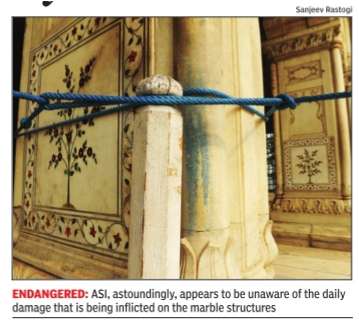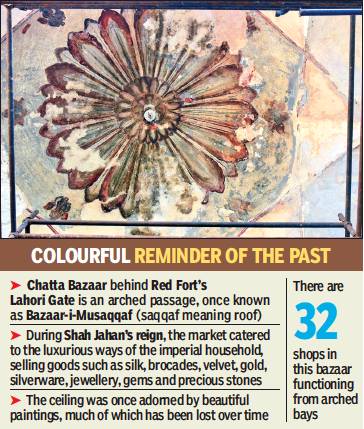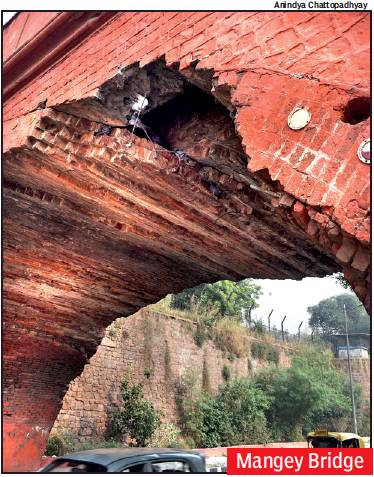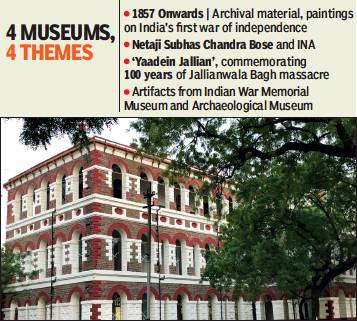Delhi: Red Fort
(→Architecture, décor) |
(→=2018: poor condition) |
||
| Line 57: | Line 57: | ||
=Mangey Bridge= | =Mangey Bridge= | ||
| − | ==2018: poor condition= | + | ==2018: poor condition== |
[https://epaper.timesgroup.com/Olive/ODN/TimesOfIndia/shared/ShowArticle.aspx?doc=TOIDEL%2F2018%2F11%2F21&entity=Ar00902&sk=8703838D&mode=text Traffic takes toll on heritage bridge, November 21, 2018: ''The Times of India''] | [https://epaper.timesgroup.com/Olive/ODN/TimesOfIndia/shared/ShowArticle.aspx?doc=TOIDEL%2F2018%2F11%2F21&entity=Ar00902&sk=8703838D&mode=text Traffic takes toll on heritage bridge, November 21, 2018: ''The Times of India''] | ||
Revision as of 23:53, 27 November 2018
This is a collection of articles archived for the excellence of their content. |
Contents |
The status of the monument
2016: some decay
Richi Verma, Callousness stains relics of history at Red Fort, Dec 8, 2016: The Times of India

For an agency entrusted with the delicate task of preserving the country's precious heritage, the Archaeological Survey of India has rather callously endangered the beauty and integrity of parts of a World Heritage Site. The marble piers, inlaid with coloured stone in the form of floral arrangements, in the Diwan-e-Khas at Red Fort in Delhi now have ugly welts of blue. There also are signs of abrasions on these precious relics of history .
ASI, astoundingly , appears to be unaware of the daily damage that is being inflicted on the marble structures, and it is enraged conservationists who have called attention to this neglect. What has irked the conservationists is the avoidable staining of the marble piers by blue plastic ropes tied to them to keep visitors at bay. For a heritage structure of the stature of Red Fort, the thoughtless -and damaging -expediency of having plastic ropes tied to the pillars instead of erecting a proper barricade could prove a costly mistake.
“Buildings of the Shah Jahan era, such as Taj Mahal and Diwan-e-Khas, are nothing less than priceless paintings and need to be treated with a high degree of sensitivity ,“ said a historian. The permanent damage done to the intricately carved pillars recall the horror of the damage done to the marble jaali at tached to the Rang Mahal a decade ago, he added.
ASI superintending archaeologist Daljit Singh was not available for comment, but sources in ASI said that the marble pillars would be cleaned of the stains. This hasn't enthused experts though.Swapna Liddle of INTACH explained that cleaning could easily mar the porous marble.“In theory , of course, ASI can scrub off the blue marking, but at what cost?“ she asked.“Chemical treatment can damage the structure and scrubbing, after all, involves the removal of a micro layer of the marble.“
Another conservationist observed that even if ASI had only ropes to fall back on in trying to cordon off the area, it could have used ropes made of natural materials. Rajeev Sethi of the Indian Heritage Foundation was more critical of the measure. “This should not have happened at all,“ he said.
The Diwan-e-Khas, or hall of private audience, was used by Mughal emperors to meet the nobility and was grandly decorated, with the lower portion of the piers bearing inlaid floral motifs and the upper portions gilded and painted.“The ceiling, which was originally inlaid with silver and gold, was stripped bare by the Jats and Marathas during the successive crises of the empire,“ informed a historian.The interiors of the audience hall were plundered in the aftermath of the war of 1857, and the throne, carpets and many other artefacts went missing. The current ceiling was installed in 1911.
Architecture, décor
Chatta Bazaar: paintings
Richi Verma, Mughal arcade reveals canvas, January 10, 2018: The Times of India

From: Richi Verma, Mughal arcade reveals canvas, January 10, 2018: The Times of India

From: Richi Verma, Mughal arcade reveals canvas, January 10, 2018: The Times of India

From: Richi Verma, Mughal arcade reveals canvas, January 10, 2018: The Times of India
Restoration Of Chatta Bazaar Inside Red Fort Exposes Exquisitely Painted Ceiling
The next time one visits the Red Fort, one would walk through a grand arcade. The ceiling of the historic Chatta Bazaar, which was once adorned with the most exquisite paintings, is getting some of its former glory back.
This original Mughal art is being painstakingly exposed and conserved by the science branch of Archaeological Survey of India. Conservation of the paintings started in early October last year, and it would take a few more months to complete. The beautiful floral and geometric patterns had been covered by multiple layers of lime plaster laid out over the years.
But the process to peel off the plasterwork is not easy. Unless it’s done with complete precision, there is risk of damage. “In each painting that is being exposed, up to seven layers of lime coating have been found at some points. And each layer has to be very carefully removed to ensure the original painting is not harmed in any way,” said an official.
ASI officials report that the frequent use of lime coating over the years in the fort, particularly during preparations for Independence Day, and painting work by the shop owners of Chatta Bazaar, hid the art work. “We trace impressions of the paintings wherever we can see or detect them, and then slowly work to remove the layers of lime to expose the paintings. And the plaster is slowly peeled away,” said an official.
Exposing the facade of Chatta Bazaar was planned in an effort to bring out the original design of the citadel. A major challenge here is to decide which layer of the painting should be exposed. “Some paintings have single layers. But some paintings also have multiple layers. In such cases, we usually keep the uppermost layer exposed even if there are more layers beneath. After all, each layer of painting is part of the fort’s history. Every effort is made to preserve whatever is available,” said an ASI official.
Exposing each painting depends on the condition of the lime plaster. At some points, the plaster is thicker and at others it’s thinner that makes scraping it away easier.
ASI hopes to unearth new, hidden information about the Red Fort from these exposed paintings. Through the centuries, Red Fort has undergone many changes. Historians say the fort is witness to many historical events, and each change within the fort is monumental. “The paintings over the Chatta Bazaar are similar testaments to many years of being under different rulers. Each painting tells a different story and we would like visitors to be able to view these paintings as well,” said an official.
Mangey Bridge
2018: poor condition
Traffic takes toll on heritage bridge, November 21, 2018: The Times of India

From: Traffic takes toll on heritage bridge, November 21, 2018: The Times of India
Major Portions Damaged From Impact Of Trucks, Buses Passing Under It
A British-era bridge that connects Red Fort with Salimgarh Fort is in an extremely poor condition with major portions of the bridge damaged on impact with heavy vehicles that regularly pass under it.
The Mangey Bridge is over a century old and is protected by the Archaeological Survey of India. It is located on the busy Ring Road and has three arches. Two lanes of the road go under each arch. Traffic movement is pretty heavy here. As a result, trucks and buses routinely hit the underside of the bridge. Over time, this has resulted in large chunks coming off. Officials have identified the root of the problem to a considerable rise in the road level under the bridge in recent years due to constant relaying.
Earlier, ASI had requested traffic police to change the route taken by heavy vehicles, but it couldn’t happen.
N K Pathak, superintending archaeologist, Delhi circle, said, “The problem is that heavy vehicles drive through the bridge at high speed, sometimes hitting the structure that has led to the condition of the bridge today. I will be writing to the joint CP (traffic), asking him to erect height barriers at the two side arches to stop heavy vehicles from passing underneath. Heavy vehicles can pass through the middle arch where the road level is lower.”
Installing height barriers is routinely done by traffic police to restrict movement of heavy vehicles, and was also done at Tripolia Gateways in north Delhi—another ASI monument which suffered similar damage due to heavy vehicles passing through it.
ASI officials have surveyed the bridge and taken stock of the damages. They would soon prepare estimates to start conservation work on the bridge.
“This is a routine problem with this bridge and requires a permanent solution. The location is such that it will be hit by heavy vehicles unless their movement is restricted. Even lowering the road level won’t help much,” said another ASI official.
Conservation work was done on the bridge earlier in 2010 when ASI had roped in a British firm. That time too, the bridge had sustained heavy damage. PWD had then agreed to realign the road to ensure that all heavy vehicles pass through the arch where the road level was the lowest. But the civic agencies kept on relaying the road every year, raising the level by several inches, an official said.
Museums
2018: Four new museums
Swati Mathur, July 15, 2018: The Times of India

From: Swati Mathur, July 15, 2018: The Times of India
Come August, four new museums at the Red Fort will open to the public, enriching Delhi’s cultural scene and giving people a glimpse into 160 years of Indian history — from the First War of Independence in 1857 to Subhas Chandra Bose’s Indian National Army, India’s participation in World War I, and Jallianwala Bagh.
An initiative spearheaded by the Union culture ministry, the project will see a makeover of the large, erstwhile British barracks, which had been locked up till now. “The idea is to develop Red Fort as a museum hub,” said culture secretary Raghavendra Singh. The barracks are three floors high and have teakwood panelling, wooden floors and large staircases. Now they will have thematic representations of Indian history.
The first museum will contain original archival material and replicas related to 1857. Also on display will be 70 original paintings on the uprising, each of which are more than a century old. Singh said that some of the exhibits will also be borrowed from other museums like the Victorial Memorial Museum of Kolkata.
The second museum will commemorate 75 years of Netaji Subhas Chandra Bose’s INA. The museum will have displays on the INA trials held inside the Red Fort. Several officers of the INA were court martialled here in November and December 1945.
The massacre of Jallianwala Bagh, in its centenary year now, will form the bulk of the third museum, alongside archival material on India’s participation in WWI.
The fourth museum will have artifacts from the Indian War Memorial Museum and Archaeological Museum, till now housed in Naubat Khana and Mumtaz Mahal Palace respectively. After the collections are shifted, these two original Mughal buildings will be opened to public as part of the Red Fort heritage areas.
The Archaeological Survey’s superintending archaeologist N K Pathak said the aim is to educate people about Indian valour and history. Officials said the presentation styles and the stories in each museum will be unique, using a generous mix of archival material and state-of-the-art technology to create an immersive experience for students of history.
Incidentally, a fifth museum, on martyrs of India’s independence movement, has also been planned. However, the site is yet to be finalised, although it will also be within the Red Fort precincts.